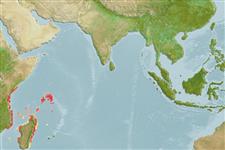Elasmobranchii (sharks and rays) >
Orectolobiformes (Carpet sharks) >
Ginglymostomatidae (Nurse sharks)
Etymology: Pseudoginglymostoma: Pseudoginglymostoma brevicaudatum (Günther 1867) (See ETYFish); brevicaudatum: Brevis (L.), short; caudatus (L.), tailed, referring to caudal fin being less than ¼ of total length (See ETYFish).
More on author: Günther.
Environment: milieu / climate zone / depth range / distribution range
Ecology
Marine; reef-associated. Tropical; 0°S - 27°S, 38°E - 58°E
Western Indian Ocean: East Africa, and possibly Mauritius and Seychelles.
Size / Weight / Age
Maturity: Lm ? range ? - ? cm
Max length : 75.0 cm TL male/unsexed; (Ref. 247)
Short description
Identification keys | Morphology | Morphometrics
Dark brown dorsally, slightly paler ventrally (Ref. 391).
A little-known inshore bottom shark of the continental and insular shelves. Well adapted to lie amongst coral reefs due to its tough skin (Ref. 391); depth data not available (Ref. 43278). Breeding and feeding habits are unknown. Presumably oviparous (Ref. 50449). Survives for many hours out of water (Ref. 391).
Life cycle and mating behavior
Maturity | Reproduction | Spawning | Eggs | Fecundity | Larvae
Probably oviparous (Ref. 50449).
Compagno, L.J.V., 1999. Checklist of living elasmobranchs. p. 471-498. In W.C. Hamlett (ed.) Sharks, skates, and rays: the biology of elasmobranch fishes. Johns Hopkins University Press, Maryland. (Ref. 35766)
IUCN Red List Status (Ref. 130435: Version 2024-2)
Threat to humans
Harmless
Human uses
Fisheries: subsistence fisheries
Tools
Special reports
Download XML
Internet sources
Estimates based on models
Phylogenetic diversity index (Ref.
82804): PD
50 = 1.0625 [Uniqueness, from 0.5 = low to 2.0 = high].
Bayesian length-weight: a=0.00417 (0.00157 - 0.01105), b=3.08 (2.85 - 3.31), in cm total length, based on LWR estimates for this (Sub)family-body shape (Ref.
93245).
Trophic level (Ref.
69278): 3.8 ±0.3 se; based on size and trophs of closest relatives
Resilience (Ref.
120179): Low, minimum population doubling time 4.5 - 14 years (Fec assumed to be <100).
Fishing Vulnerability (Ref.
59153): Moderate to high vulnerability (50 of 100).
